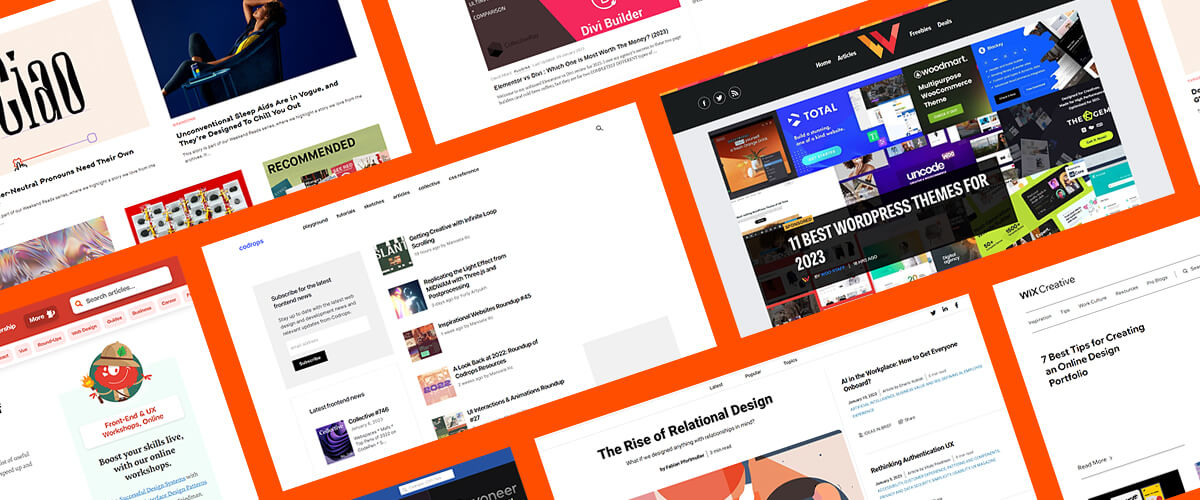Want to learn web design? Let me save you from wasting six months on the wrong things.
I’ve hired over 100 designers in my 20-year career. Reviewed thousands of portfolios. Watched talented beginners become six-figure earners. And seen plenty of others wash out despite having all the “right” credentials.
The difference isn’t what you’d think.
It’s not about mastering every tool. Not about having a computer science degree. Not even about being naturally artistic.
The designers who succeed understand something most courses won’t teach you: Web design is about solving business problems, not making pretty websites.
And here’s what nobody’s talking about: AI just made this even more true.
Why most web design education fails you
Every web design course starts the same way. HTML basics. CSS fundamentals. Maybe some JavaScript. Color theory. Typography rules.
Months later, you can build a website. Congrats. So can a million other people. And now, so can AI.
But can you build a website that actually converts visitors into customers? Can you explain why one design choice will make more money than another? Can you talk to clients without making their eyes glaze over?
That’s what separates working designers from people with web design skills.
I learned this pattern after years of hiring. Early on, I hired designers based on their technical skills. Perfect code. Beautiful portfolios. Knew every CSS trick in the book.
Most of them couldn’t handle real client work. They’d spend days perfecting animations while ignoring conversion goals. They’d argue about color choices without understanding the brand strategy. They’d build what looked good to them, not what worked for the business.
Now I hire differently. And if you’re learning web design in 2024, you should learn differently too.
The skills that actually matter (in order of importance)
After watching over 100 designers either thrive or struggle, here’s what actually determines success:
1. Business comprehension before code perfection
The best designers I’ve hired think like business owners, not artists.
They ask questions like:
- What’s the goal of this website?
- Who’s the target customer?
- What action do we want them to take?
- How do we measure success?
You know what they don’t obsess over? Whether to use flexbox or grid. Whether the padding is 20px or 24px. Whether to use Sass or regular CSS.
Those details matter, but only after you understand the business context. And guess what? AI can handle most of those technical details now anyway.
How to develop this: Before learning any code, study landing pages that convert. Read about conversion optimization. Understand basic marketing principles. Learn what makes people buy. Use AI to analyze why certain designs work – feed it high-converting sites and ask what patterns it sees.
2. Communication skills that prevent disasters
Half of web design is translating between business speak and design speak.
Clients say things like “make it pop” or “it needs more energy.” You need to translate that into specific, actionable design changes. Then explain your choices in terms they understand.
I’ve seen technically brilliant designers fail because they couldn’t have a normal conversation with clients. They’d respond to feedback with jargon. Get defensive about critiques. Miss deadlines without communicating.
Meanwhile, designers with decent skills but great communication become indispensable. And this is where AI can’t replace you – it can’t sit in a meeting and read the room. It can’t sense when a client is frustrated but not saying it.
How to develop this: Practice explaining design choices without using design terms. Write case studies. Start a blog. Explain your work to non-designer friends. Use AI to help you translate technical concepts into business language.
3. Speed and efficiency over perfection
Real client work has deadlines. Tight ones.
In courses, you might spend weeks perfecting a single project. In agency life? You’ve got days. Sometimes hours.
The designers who succeed can produce good-enough work quickly, then iterate. They know when to stop tweaking. They understand that done beats perfect.
Here’s where AI becomes your superpower. The designers thriving today use AI to:
- Generate initial concepts in minutes
- Create variations instantly
- Handle repetitive tasks
- Build responsive layouts faster
They’re not replaced by AI. They’re 10x more productive because of it.
How to develop this: Set strict time limits for practice projects. Build a website in a day. Redesign a landing page in two hours. Use AI for the heavy lifting, then add your human touch.
4. Problem-solving over memorization
Every client project breaks your templates. Always.
Their content doesn’t fit your beautiful grid. Their logo clashes with your color scheme. They need features you’ve never built before.
The designers who last are resourceful. They Google effectively. They adapt tutorials to fit their needs. They figure things out without hand-holding.
And now? They’re AI power users. They know how to prompt ChatGPT for specific CSS solutions. They use Claude to debug JavaScript. They get unstuck in minutes, not hours.
The ones who struggle? They only know how to follow tutorials step-by-step. When something doesn’t match exactly, they’re stuck.
How to develop this: Stop following tutorials exactly. Take concepts from one tutorial and apply them differently. Break things on purpose, then fix them. Learn to prompt AI effectively – it’s like having a senior developer on call 24/7.
5. The technical minimums (yes, you still need these)
Even with AI, you need technical fundamentals. Not to build everything from scratch, but to understand what you’re doing and fix what AI generates.
HTML/CSS: Non-negotiable basics: You need to understand structure and styling. AI can write the code, but you need to know if it’s good code.
Focus on:
- Semantic HTML (using the right tags for the job)
- CSS Grid and Flexbox for layouts
- Responsive design principles
- How to modify AI-generated code
Skip (for now):
- Memorizing every property
- Complex animations that kill performance
- Writing everything from scratch
JavaScript: Just enough to be dangerous: You don’t need to be a JavaScript developer. You need enough to work with AI-generated code and common tools.
Learn:
- Reading and understanding code
- Basic debugging
- Working with libraries/frameworks
- How to prompt AI for JavaScript solutions
Design tools: Pick one and master it Figma, Sketch, XD, whatever. Now many have AI built in. Figma’s AI can generate designs from text prompts. But you still need to know design principles to judge if they’re good.
The AI reality for new designers
Let’s address the elephant: “Will AI replace designers?”
After 20 years of watching this industry evolve, here’s the truth: AI will replace designers who only push pixels. It won’t replace designers who solve business problems.
AI can:
- Generate layouts
- Write code
- Create variations
- Handle repetitive tasks
- Fix technical issues
AI can’t:
- Understand business context
- Navigate client politics
- Make strategic decisions
- Build trust with stakeholders
- Know when to break rules
The designers getting hired today use AI as a power tool, not a replacement. They’re faster and more capable than ever. But they’re valuable because of their judgment, not their technical skills.
The fastest path to paid work
Want to shortcut the learning curve? Here’s exactly what I’d do if starting today:
Month 1: Foundation + First projects
Week 1-2: Speed-run the basics with AI assistance
- Take a crash course in HTML/CSS fundamentals
- Use AI to explain concepts you don’t understand
- Build three simple pages using AI for boilerplate code
- Focus on understanding what the code does, not writing it all
Week 3-4: Design thinking + AI tools
- Learn one design tool (Figma’s free and has AI features)
- Study 10 high-converting websites
- Use AI to analyze what makes them work
- Recreate two using AI assistance for code
Month 2: Real projects + Portfolio
Find three real clients:
- Family member’s business
- Local nonprofit
- Friend’s side project
Use AI to accelerate delivery but add human strategy. Document everything: the brief, your process, the business results.
Month 3: Positioning + Paid work
Build a portfolio that shows:
- Business problems you solved
- How you think (not just what you made)
- Your process combining human insight with AI efficiency
Start at $500-1500 per project. You’re learning fast with AI assistance, and delivering real value.
What separates the pros from the eternal students
I see the same patterns after 20 years. Some designers are earning good money within six months. Others are still watching tutorials two years later.
The difference?
The pros ship work. They use every tool available – including AI – to deliver value faster. They get feedback. They improve through practice.
The students perfect their process. They take another course. Worry about AI replacing them. Polish their personal site forever. But they don’t ship.
Every successful designer I know has a portfolio full of imperfect early work. But they learned by doing, not preparing.
The reality check most courses won’t give you
Learning web design is straightforward. Building a career is harder.
The market is competitive. AI is changing everything. Clients can be difficult. Deadlines are stressful.
But here’s what’s also true:
Good designers are more valuable than ever. AI raised the bar for basic work, but it also created opportunities for those who can leverage it strategically.
If you can communicate well, solve business problems, and use AI to deliver faster? You’ll have more work than you can handle.
I know because I’m constantly looking for these designers. After hiring over 100, I can tell you: they’re surprisingly hard to find.
Your next move (if you’re serious)
Stop reading about web design. Start building.
Pick a local business with a terrible website. Redesign it (unsolicited). Use AI to speed up the technical parts. Focus your energy on improving their business.
Can you make their phone number easier to find? Their services clearer to understand? Their contact form less confusing?
Do that five times. You’ll learn more than six months of tutorials.
And if you create something great? Send it to them. Worst case, they ignore you. Best case, you land your first client.
That’s how careers actually start. Not with perfect knowledge. With imperfect action.
The tools change. The principles don’t. Now go build something.




